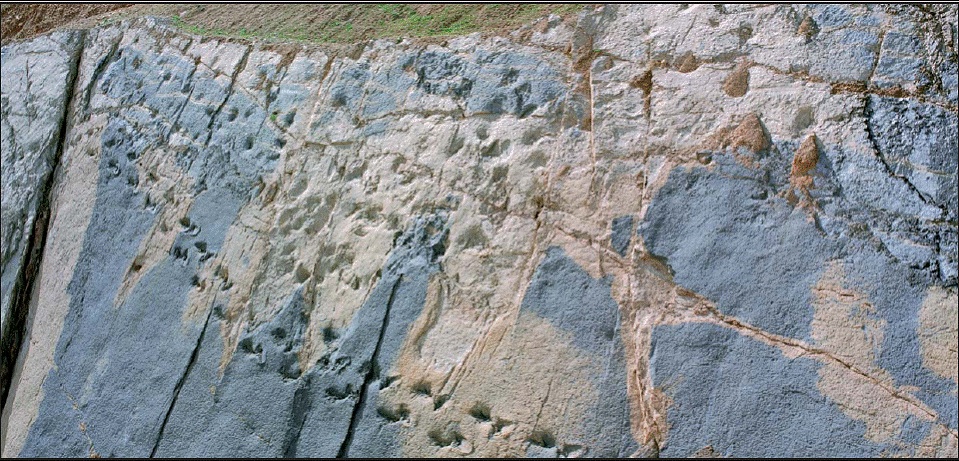El registro Ibérico (España y Portugal) de icnitas de saurópodos está representado por más de cien yacimientos en un intervalo temporal del Jurásico Medio (Batoniense) al Cretácico Superior (Maastrichtiense). Muchos de ellos conservan varias icnitas del mismo individuo ordenadas en rastros. Precisamente el estudio detallado de estos rastros en un área geográfica como es la Península Ibérica a lo largo del tiempo ha permitido hacer algunas inferencias paleoecológicas sobre donde y como vivieron los saurópodos ibéricos
Los rastros de los saurópodos ibéricos presentan dos patrones de movimiento distintos. Los hay claramente que siguen una dirección (direccionales) y otros completamente aleatorios. Los rastros formados con un comportamiento claramente gregario, es decir con rastros paralelos, se observan en los icnotipos “Parabrontopodus/Breviparopus-like” y “ Brontopodus- like” en saurópodos del mismo tamaño (pequeño o medio), lo que indica segregación por edad. Las icnitas de tipo Parabrontopodus/Breviparopus-like se ha conservado en sedimentos depositados en ambientes terrestres mientras que los de Brontopodus- like lo hace fundamentalmente en ambientes costeros.
Los rastros formados por individuos solitarios son, en su mayoría, de saurópodos de tamaño medio o grande, conservados tanto en medios terrestres, como costeros y pertenecen a los dos icnotipos mencionados anteriormente y a un tercero: “Polyonyx-like”. Por lo tanto, no hay una significativa influencia paleoambiental en el registro del comportamiento gregario de los saurópodos ibéricos. Sin embargo, los rastros que muestran caracteres de saurópodos Titanosauriformes (Brontopodus -like) son más frecuentes en los medios costeros de la Península Ibérica. Estos resultados son diferentes a los expuestos por otros autores que apuntan una aparente preferencia de los Titanosauriformes por los medios terrestres.
El resumen original es
More than a hundred sauropod tracksites, ranging in age from Middle Jurassic (Bathonian) to Late Cretaceous (Maastrichtian), are repor ted from the Iberian Peninsula (Spain and Portugal). Sauropod trackway orientation patterns throughout an entire geographic area such as the Iberian Peninsula and over different time periods may provide new data about the palaeoecology and behavioural patterns of sauropods. The studied tracksites exhibit two main trackway orientation patterns, directional and random, indicating different behaviours in gregarious or solitary (milling) individuals. Gregarious behavioural patterns are mainly observed within Parabrontopodus/Breviparopus-like and Brontopodus-like ichnotypes of a single size class (either small or medium-sized), indicating age segregation.
Among the gregarious sauropods the former ichnotype is linked with inland environments, while the latter is mainly linked with coastal environments. Solitary trackways are mainly of medium-sized to large individuals, are also linked with both inland (Parabrontopodus/Breviparopus-like) and coastal environments (Parabrontopodus/Breviparopus-like, Brontopodus-like), and belong to the above-mentioned ichnotypes as well as to Polyonyx-like ichnotypes. Thus, no obvious link between gregarious behaviour and the palaeoenvironmental setting can be inferred from the sauropod track record of the Iberian Peninsula. Nonetheless, sauropod trackways showing titanosauriform characters (Brontopodus-like) are more common in coastal environments, contrary to what might be expected given this group’s apparent taxonomic preference for inland environments
La referencia completa es. Castanera, D., Vila, B., Razzolini, N.L., Santos, V.F., Pascual, C., Canudo, J.I. 2014. Sauropod trackways of the iberian Peninsula: palaeotological and palaeoenvironmental implications. Journal of Iberian Geology, 40, 1, 49-59.
Los rastros de los saurópodos ibéricos presentan dos patrones de movimiento distintos. Los hay claramente que siguen una dirección (direccionales) y otros completamente aleatorios. Los rastros formados con un comportamiento claramente gregario, es decir con rastros paralelos, se observan en los icnotipos “Parabrontopodus/Breviparopus-like” y “ Brontopodus- like” en saurópodos del mismo tamaño (pequeño o medio), lo que indica segregación por edad. Las icnitas de tipo Parabrontopodus/Breviparopus-like se ha conservado en sedimentos depositados en ambientes terrestres mientras que los de Brontopodus- like lo hace fundamentalmente en ambientes costeros.
Los rastros formados por individuos solitarios son, en su mayoría, de saurópodos de tamaño medio o grande, conservados tanto en medios terrestres, como costeros y pertenecen a los dos icnotipos mencionados anteriormente y a un tercero: “Polyonyx-like”. Por lo tanto, no hay una significativa influencia paleoambiental en el registro del comportamiento gregario de los saurópodos ibéricos. Sin embargo, los rastros que muestran caracteres de saurópodos Titanosauriformes (Brontopodus -like) son más frecuentes en los medios costeros de la Península Ibérica. Estos resultados son diferentes a los expuestos por otros autores que apuntan una aparente preferencia de los Titanosauriformes por los medios terrestres.
El resumen original es
More than a hundred sauropod tracksites, ranging in age from Middle Jurassic (Bathonian) to Late Cretaceous (Maastrichtian), are repor ted from the Iberian Peninsula (Spain and Portugal). Sauropod trackway orientation patterns throughout an entire geographic area such as the Iberian Peninsula and over different time periods may provide new data about the palaeoecology and behavioural patterns of sauropods. The studied tracksites exhibit two main trackway orientation patterns, directional and random, indicating different behaviours in gregarious or solitary (milling) individuals. Gregarious behavioural patterns are mainly observed within Parabrontopodus/Breviparopus-like and Brontopodus-like ichnotypes of a single size class (either small or medium-sized), indicating age segregation.
Among the gregarious sauropods the former ichnotype is linked with inland environments, while the latter is mainly linked with coastal environments. Solitary trackways are mainly of medium-sized to large individuals, are also linked with both inland (Parabrontopodus/Breviparopus-like) and coastal environments (Parabrontopodus/Breviparopus-like, Brontopodus-like), and belong to the above-mentioned ichnotypes as well as to Polyonyx-like ichnotypes. Thus, no obvious link between gregarious behaviour and the palaeoenvironmental setting can be inferred from the sauropod track record of the Iberian Peninsula. Nonetheless, sauropod trackways showing titanosauriform characters (Brontopodus-like) are more common in coastal environments, contrary to what might be expected given this group’s apparent taxonomic preference for inland environments
La referencia completa es. Castanera, D., Vila, B., Razzolini, N.L., Santos, V.F., Pascual, C., Canudo, J.I. 2014. Sauropod trackways of the iberian Peninsula: palaeotological and palaeoenvironmental implications. Journal of Iberian Geology, 40, 1, 49-59.
LUGAR



















